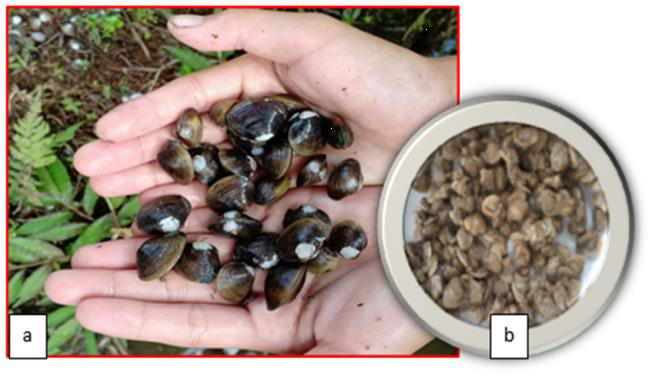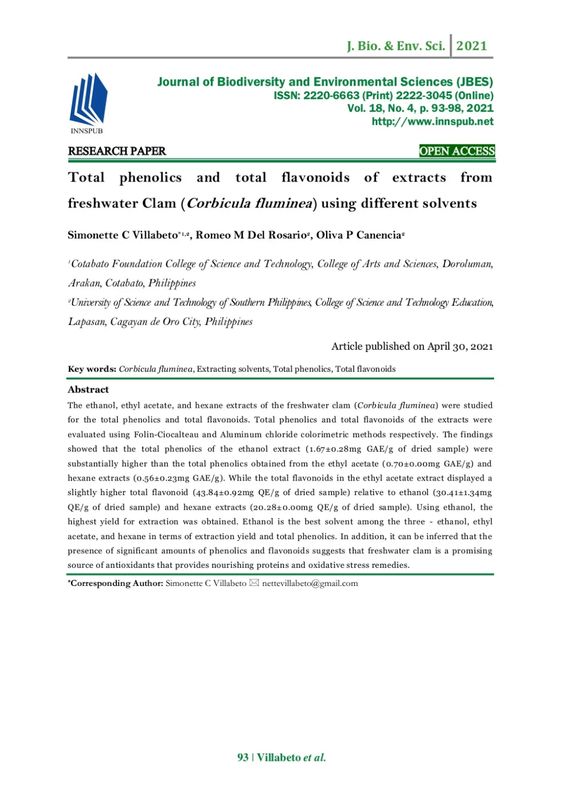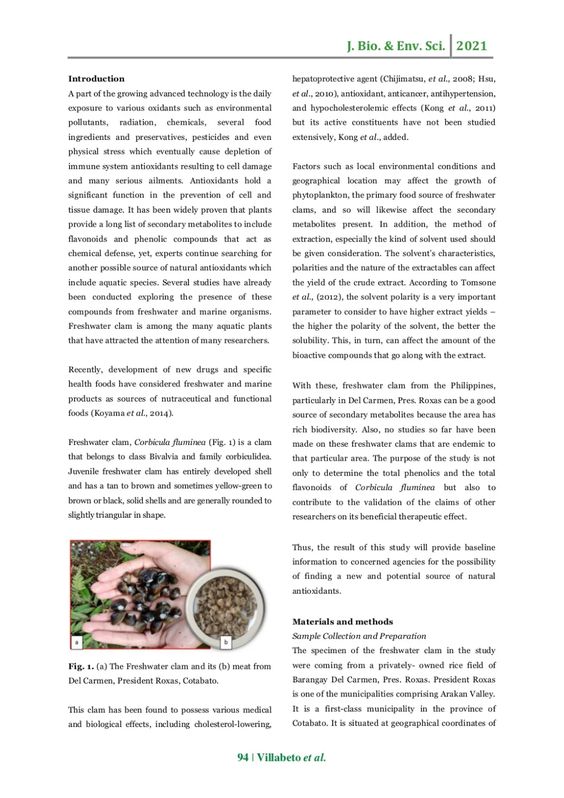
Mr. Simonette C Villabeto, Romeo M Del Rosario, and Oliva P Canencia from the institute of the Cotabato Foundation College of Science and Technology, College of Arts and Sciences, Doroluman, Arakan, Cotabato, Philippines, and University of Science and Technology of Southern Philippines, College of Science and Technology Education, Lapasan, Cagayan de Oro City, Philippines wrote a research paper entitled “Total phenolics and total flavonoids of extracts from freshwater Clam (Corbicula fluminea) using different solvents” Let’s get some knowledge about it.
Abstract
The ethanol, ethyl acetate, and hexane extracts of the freshwater clam (Corbicula fluminea) were studied for the total phenolics and total flavonoids. Total phenolics and total flavonoids of the extracts were evaluated using Folin-Ciocalteau and Aluminum chloride colorimetric methods respectively. The findings showed that the total phenolics of the ethanol extract (1.67±0.28mg GAE/g of dried sample) were substantially higher than the total phenolics obtained from the ethyl acetate (0.70±0.00mg GAE/g) and hexane extracts (0.56±0.23mg GAE/g). While the total flavonoids in the ethyl acetate extract displayed a slightly higher total flavonoid (43.84±0.92mg QE/g of dried sample) relative to ethanol (30.41±1.34mg QE/g of dried sample) and hexane extracts (20.28±0.00mg QE/g of dried sample). Using ethanol, the highest yield for extraction was obtained. Ethanol is the best solvent among the three – ethanol, ethyl acetate, and hexane in terms of extraction yield and total phenolics. In addition, it can be inferred that the presence of significant amounts of phenolics and flavonoids suggests that freshwater clam is a promising source of antioxidants that provides nourishing proteins and oxidative stress remedies

Introduction
A part of the growing advanced technology is the daily exposure to various oxidants such as environmental pollutants, radiation, chemicals, several food ingredients and preservatives, pesticides and even physical stress which eventually cause depletion of immune system antioxidants resulting to cell damage and many serious ailments. Antioxidants hold a significant function in the prevention of cell and tissue damage. It has been widely proven that plants provide a long list of secondary metabolites to include flavonoids and phenolic compounds that act as chemical defense, yet, experts continue searching for another possible source of natural antioxidants which include aquatic species. Several studies have already been conducted exploring the presence of these compounds from freshwater and marine organisms.
Freshwater clam is among the many aquatic plants that have attracted the attention of many researchers. Recently, development of new drugs and specific health foods have considered freshwater and marine products as sources of nutraceutical and functional foods (Koyama et al., 2014). Freshwater clam, Corbicula fluminea (Fig. 1) is a clam that belongs to class Bivalvia and family corbiculidea. Juvenile freshwater clam has entirely developed shell and has a tan to brown and sometimes yellow-green to brown or black, solid shells and are generally rounded to slightly triangular in shape. Fig. 1. (a) The Freshwater clam and its (b) meat from Del Carmen, President Roxas, Cotabato. This clam has been found to possess various medical and biological effects, including cholesterol-lowering, hepatoprotective agent (Chijimatsu, et al., 2008; Hsu, et al., 2010), antioxidant, anticancer, antihypertension, and hypocholesterolemic effects (Kong et al., 2011) but its active constituents have not been studied extensively, Kong et al., added. Factors such as local environmental conditions and geographical location may affect the growth of phytoplankton, the primary food source of freshwater clams, and so will likewise affect the secondary metabolites present.
In addition, the method of extraction, especially the kind of solvent used should be given consideration. The solvent’s characteristics, polarities and the nature of the extractables can affect the yield of the crude extract. According to Tomsone et al., (2012), the solvent polarity is a very important parameter to consider to have higher extract yields – the higher the polarity of the solvent, the better the solubility. This, in turn, can affect the amount of the bioactive compounds that go along with the extract. With these, freshwater clam from the Philippines, particularly in Del Carmen, Pres. Roxas can be a good source of secondary metabolites because the area has rich biodiversity. Also, no studies so far have been made on these freshwater clams that are endemic to that particular area. The purpose of the study is not only to determine the total phenolics and the total flavonoids of Corbicula fluminea but also to contribute to the validation of the claims of other researchers on its beneficial therapeutic effect. Thus, the result of this study will provide baseline information to concerned agencies for the possibility of finding a new and potential source of natural antioxidants. Check out more Total phenolics and total flavonoids of extracts from freshwater Clam (Corbicula fluminea) using different solvents
Reference
Adaramola B, Onigbinde A. 2016. Effect of Extraction Solvent on the Phenolic Content, Flavonoid Content and Antioxidant Capacity of Clove Bud. IOSR Journal of Pharmacy and Biological Sciences II(3)I, 33-38.
Bag GC, Devi PG, Bhaigyabati Th. 2015. Assessment of Total Flavonoid Contents and Antioxidant Activity of Methanolic Rhizome Extract of Three Hedychium Species of Manipur Valley. Int. J. Pharm. Sci. Rev. Res 30(1), 154-159
Beecher GR. 2003. Overview of dietary flavonoids: nomenclature, occurrence and intake. Jour Nut 133, 3248-3254.
Chijimatsu T, Tatsugushi I, Abe K, Oda H, Mochizuki S. 2008. A Freshwater clam (Corbicula fluminea) extract improves cholesterol metabolism in rats fed on a high-cholesterol diet. Bioscience Biotechnology and Biochemistry 72(10), 2566-2571.
Do QM, Ankkawijaya AE, Nguyen PLT, Huynh LH, Soetaredjo FE, Ismadji S. 2014. Effect of extraction solvent on total phenol content, total flavonoid content, and antioxidant activity of Limnophila aromatic. Journal of Food and Drug Analysis 22, 296-302.
Eswar A, Isha Z, Shanmugasundaram S, Ramamoorthy K, Nanda RK. 2015. Evaluation of preliminary qualitative analysis of Clam Paphia malabarica extracts from Girgaon chowpatty Creek, Mumbai. Journal of Pharmaceutical, Chemical and Biological Sciences 3(4), 461-468.
Hsu CL, Hsu CC, Yen GC. 2010, Hepatoprotection by freshwater clam extract against CCl4-induced hepatic damage in rats. Am. J. Chin. Med 38, 881-894.
Khedher O, Moussaoui Y, Salem RB. 2014. Solvent Effects on Phenolic Contents and Antioxidant Activities of the Echinops Spinosus and the Limoniastrum Monopetalum Research Journal of Pharmaceutical, Biological and Chemical Sciences 5(2), 66-76.
Kong ZL, Yu SC, Dai SA, Tu CC, Pan MH, Liu YC. 2011. Polyoxygenated Sterols from freshwater Clam. Helvetica Chimica Acta Vol. 94.
Koyama T, Chounan R, Uemura D, Yamaguchi K, Yazawa K. 2006. Hepatoprotective effect of a hot-water extract from the edible thorny oyster Spondylus varius on carbon tetrachloride -induced liver injyury in mice. Biosci. Biotechnol. Biochem 70(3), 729-731.
Michiels JA, Kevers C, Pincemail J, Defraigne JO, Dommes J. 2012. Extraction conditions can greatly influence antioxidant capacity assays in plant food matrices. Food Chemistry 130(4), 986-993.
Ngo TV, Scarlett CJ, Bowyer MC, Ngo PD, Vuong QV. 2017. Impact of Different Extraction Solvents on Bioactive Compounds and Antioxidant Capacity from the Root of Salacia chinensis L. Journal of Food Quality Volume 2017.
Ramasamy M, Balasubramanian U. 2012. Identification of Bioactive Compounds and Antimicrobial Activity of Marine Clam Anadara Granosa (Linn.). International Journal of Science and Nature 3(2), 263-266.
Settharaksa S, Madaka F, Sueree L, Kittiwisut S, Sakunpak A, Moton C, Charoenchai L. 2014. Effect of Solvent Types on Phenolic, Flavonoid Contents and Antioxidant Activities of Syzygium gratum (Wight) S.N. Int J Pharm Pharm Sci 6(2), 114-116.
Tomsone L, Kruma Z, Galoburda R. 2012. Comparison of Different Solvents and Extraction Methods for Isolation of Phenolic Compounds from Horseradish Roots (Armoracia rusticana). International Journal of Agricultural and Biosystems Engineering 6(4), 236-241.


